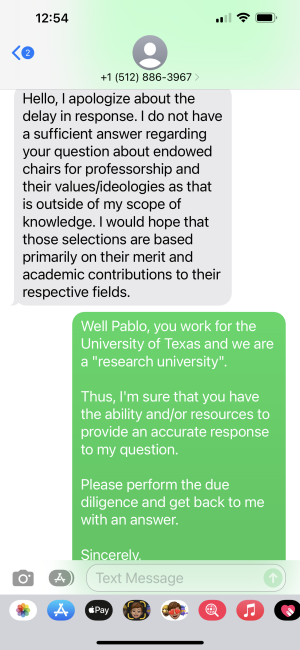Pineapple
Legendary
Shared it for you
Love it!!!!!
Shared it for you
@Pineapple did that @MortgageHorn try and entice Miss Staci? Why that dirty dog. You best drop Miss Staci off with Old Man, I will protect her for yah. I got your back @Pineapple.Nothing but love, @MortgageHorn
Nobody better lay a finger on my Stacey. That’s all mine.@Pineapple did that @MortgageHorn try and entice Miss Staci? Why that dirty dog. You best drop Miss Staci off with Old Man, I will protect her for yah. I got your back @Pineapple.
Well there we have it boys. You Put Out A Hand You Pull Back A Stump. Ol @Pineapple means business.Nobody better lay a finger on my Stacey. That’s all mine.
My Conversation Text With a Univerisity of Texas Fundraiser
View attachment 112657
View attachment 112658


YesHas anyone purchased emergency food supply from anywhere? Any suggestions from those who have.




And don't forget cannons, you could literally have a cannonAgain…
1. Puckle Gun - precursor to the Gatlin.
2. Kalthoff Repeater - 30-60 rounds a minute.
3. Cookson Repeater - 14 round drum. So, you could literally carry several drums to fire more rounds quickly.
4. Duckfoot pistols - usually 4-5 barrels.
Fuck off with the ignorance, Liberals. Everyone of these was around BEFORE The 2nd Amendment!
Two of 19 Hot takes from Blue Checkmarks.
Cont

 conservativebrief.com
conservativebrief.com


“According to the Federal Bureau of Investigation (FBI), a mass murder occurs when at least four people are murdered, not including the shooter … during a single incident …
Seemingly every time a mass shooting occurs … the anti-gun media and politicians have a knee-jerk response — they blame the tragedy solely on the tool used, namely firearms, and focus all of their proposed ‘solutions’ on more laws, ignoring that the murderer already broke numerous laws when they committed their atrocity.
Facts matter when addressing such an emotionally charged topic, and more gun control legislation has shown that law-abiding Americans who own guns are NOT the problem. Consider the following: The more gun control laws that are passed, the more mass murders have occurred.
According to the Crime Prevention Research Center,4 97.8 percent of public shootings occur in ‘gun-free zones’ – and ‘gun-free zones’ are the epitome of the core philosophical tenet of gun control, that laws are all the defense one needs against violence …Whether or not this is correlation or causation is debatable. What is not debatable is that this sick phenomenon of mass murderers targeting ‘gun-free zones,’ where they know civilian carry isn’t available to law-abiding Americans, is happening.
This debate leads them away from the elephant in the room and one of the real issues behind mass shootings — mental health and prescription drugs.
Ignoring what’s going on in the heads of these psychopaths not only allows mass shootings to continue, it leads to misguided gun control laws that violate the Second Amendment and negate the rights of law-abiding U.S. citizens.
As Jeff Snyder put it in The Washington Times: ‘But to ban guns because criminals use them is to tell the innocent and law-abiding that their rights and liberties depend not on their own conduct, but on the conduct of the guilty and the lawless, and that the law will permit them to have only such rights and liberties as the lawless will allow.’”

Riot season is about to heat upJoe Biden Furious After Supreme Court Ruling On New York Concealed Carry Law
LOL Tater can Fuck right off....
View attachment 112665
Conservative Brief
Advertisement Advertisement OPINION: This article may contain commentary which reflects the author's opinion. Advertisement Advertisement Advertisementconservativebrief.com
SSRIs can also cause emotional blunting and detachment, such that patients report “not feeling” or “not caring” about anything or anyone, as well as psychosis and hallucinations. All of these side effects can contribute to someone acting out an unthinkable violent crime.“Anxiety, agitation, panic attacks, insomnia, irritability, hostility (aggressiveness), impulsivity, akathisia (psychomotor restlessness), hypomania, and mania have been reported in adult and pediatric patients being treated with antidepressants for major depressive disorder as well as for other indications, both psychiatric and nonpsychiatric.”
“Participants who did not meet the 12-month MDE criteria reported less distress and impairment in role functioning and used fewer services. A majority of both groups, however, were prescribed and used psychiatric medications.
Conclusion: Depression overdiagnosis and overtreatment is common in community settings in the USA. There is a need for improved targeting of diagnosis and treatments of depression and other mental disorders in these settings.”

NY Gov. Hochul defiant after Supreme Court gun decision: 'We're just getting started'
New York Gov. Kathy Hochul condemned a Supreme Court decision striking down a state law that restricted Americans' access to concealed carry permits Thursday.www.foxnews.com
You forgot “buck-fanged.”She's a retarded, inbred, horsefaced twat
No. We've been down that road before. The conversation moves on if I keep my mouth shut although I selectively toss in a comment or two with other family members but loud enough for others to hear. The light is slowly coming on.Did you ask them to show you the science behind that comment?
Last pic looks like good shark bait...
I was at Costco today. In the dry foods section I saw buckets of this stuff for $59.95. Each had 124 portions of food packets including packets of dried milk, dried orange juice and several dried pudding type desserts.Has anyone purchased emergency food supply from anywhere? Any suggestions from those who have.
You forgot “buck-fanged.”
pedo

Georgia is gone. They needed Brad to win to secure the victory for Abrams in November.GA's election system is Hot Garbage.

BREAKING: VoterGA Challenges Georgia Secretary of State Raffensperger’s GOP Primary Results | The Gateway Pundit | by Joe Hoft
VoterGA Challenges Raffensperger’s SOS Primary Results after 81 Counties Fail to Provide Public Election Certifications.www.thegatewaypundit.com
I'm Ready to Go Back To a Pen & Inkwell
The 1st Amendment Wasn't Meant for Computers and Ipads
